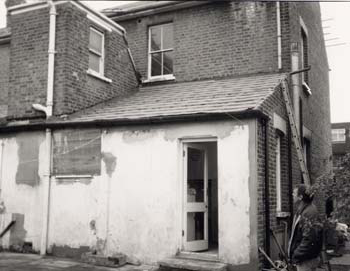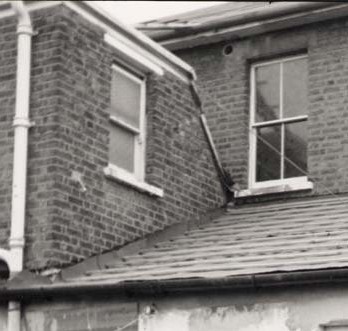



BIOCIDES
Vulnerable group
Related hazards
Front elevation of flat
All ages
VOCs
HHSRS VERSION 2
SEPTEMBER 2004
HHSRS VERSION 2
Multiple locations
Yes
No
Secondary hazards
Yes
No
Rear elevation of flat
A)
Insecticide: This is a conversion of a former HMO into three self-contained dwellings. During the
conversion works, woodworm infestation to first floor landing was discovered. On further
investigation, it was clear that there was a live woodworm infestation affecting timber to the whole of
the first floor and to most of the ground to first floor staircase. All the timber to the first floor and the
staircase was stripped out and renewed with timber treated with insecticide to prevent re-infestation.
The remaining timber to the dwelling, including the ground floor floor, the first floor ceiling and the
roof timbers were thoroughly treated. Following the timber treatment, the windows in the treated
rooms were left open for only a limited period, being subject to the presence of the builders and
reasonable weather conditions. However, within a week of the completion of the conversion, less
than two months after the completion of the timber treatment, all the flats were occupied.
LIST OF RELEVANT MATTERS
LIKELIHOOD & OUTCOMES
A
a
Use of biocides
3
b
Misuse - re. Instructions etc
3
A
-
Seriously defective
Defective
Not satisfactory
Satisfactory/NA
Front of block during conversion
Rear of block during conversion
DESCRIPTION OF HAZARDS
Dwelling: First floor flat in 1900 detached house.
# Secondary hazards
-
None
Key
3
2
1
-
A B C D E F G H
I
J
Average likelihood, outcomes and HHSRS score for biocides for all persons in pre 1920
HMOs.
HHSRS VERSION 2
SEPTEMBER 2004
HEALTH AND SAFETY RATING SYSTEM SCORES
Pre 1920 Non s.c. Flat
1 in
18
LIKELIHOOD
Low
High
Average: 513,333
Example
18
< 4200 2400 1300 750 420 240 130
75
42
24
13
7.5
4
2.5
1.5 >
Justification
OUTCOMES
Class I
Class II
Class III
Class IV
Justification
RATING
All the new timber and all the remaining old timber have been treated with biocides. Until
fumes have fully dispersed, the occupants of each flat will be at risk, particularly those in
the first floor flats. Although the fumes emitted are likely to reduce to safe levels after
two to three months, until then, the occupants are exposed to dangerous levels.
%
Average: 0.0
0.0
< 0.05 0.15 0.3
0.7
1.5
3
7
15
26
38 >
Av: 0.0
0.0
< 0.05 0.15 0.3
0.7
1.5
3
7
15
26
38 >
Av: 9.1
31.6
< 0.05 0.15 0.3
0.7
1.5
3
7
15
26
38 >
Av: 90.9
68.4
Score:
<1
0.0
0.0
31.6
68.4
< 0.05 0.15 0.3
0.7
1.5
3
7
15
26
38 >
As all rooms have been treated, including bedrooms, occupants cannot escape the
fumes, and the likelihood of harm is increased by the prolonged exposure.
Average: <1
I
J
Example
A B C D E F G H
564
Score
RATING SCORES AFTER IMPROVEMENT
IMPROVE
Justification
NEW RATING
Av: Nos
Likelihood to
1 in 5,600
Outcomes to
0
0
10.0 90.0 %
The occupants should be rehoused temporarily and each dwelling thoroughly ventilated
before the occupants move back. To have reduced the likelihood of the hazard
occurring, the use of any biocide should have been limited or, if possible, avoided.
Where used, all treated areas should have been well ventilated. New timber need not
have been treated.
Improved